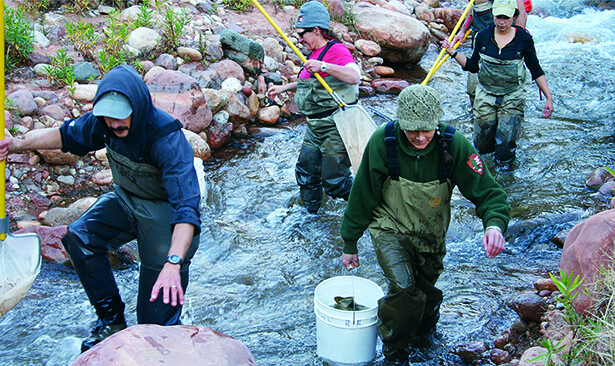October 2, 2014–January 17, 2015
ASU Art Museum
Arizona State University’s Herberger Institute for Design and the Arts
51 East 10th Street
Tempe, Arizona 85281
asuartmuseum.asu.edu
In an age of uncertainty, artists Bryndís Snæbjörnsdóttir (Iceland) and Mark Wilson (UK) investigate the balances and tipping points in human intervention in nature. The exhibition, Trout Fishing in America and Other stories, examines how ecologies can change radically as a result of tiny individual actions by human or other agents. Over a two-year period, they explored scientific conservation initiatives in Arizona and, taking a notional “vertical slice” through the Grand Canyon, they focused on the reintroduction of two endangered species—the Humpback Chub, native to the Colorado River, and the California Condor, whose zones of flight extend from the Canyon to the Vermilion Cliffs and into Utah.
This project is the artists’ first in the US and the title references Richard Brautigan’s 1967 novella Trout Fishing in America. Brautigan’s tales, anecdotes and poetic ruminations bring alive our relationship to water and things found in water, elegizing a way of wonder in our dealings with environment. Snæbjörnsdóttir and Wilson’s exhibition investigates tensions and cooperation among scientific, public, and corporate stakeholders in how we consider nature in our management of wild and public lands. In their videos, photographs and site-specific installations, the artists capture the complexity of groups all vying for their specific interests and ideas concerning the future of endangered species. We hear about the demise of the Humpback Chub due to the introduction of trout in the Colorado River in the 1920s and subsequent building of the Glen Canyon Dam 50 years ago this year. The diverse groups involved—anglers, biologists, park rangers, water authorities and the general public—provide sometimes overlapping and sometimes competing perspectives on these animals and their futures.
Scientists make of nature a laboratory, focusing on locations and species for the collection and processing of hard data. As artists, Snæbjörnsdóttir and Wilson broaden the enterprise by inviting a range of associated humans and nonhumans to the conversation and deploying affective, speculative and creative agencies. They consider the scientific work within cultural and social contexts. The exhibition provokes wonder about human-animal interactions through strategies of humor, contradiction, absurdity, surprise and lateral (rather than direct) representation. According to the artists, Trout Fishing in America and Other stories was conducted, “in a combined spirit of respect, reportage, mischief, poetry and imagination.”
Since 2001, Snæbjörnsdóttir and Wilson have been making work in response to the uncertainty in relationships between animals and humans. Their inquiries have touched on extinction, colonialism, the naming of things, pet habitats, urban pest control and hunting, among other concerns. The common thread is the examination of inconsistencies in our human relationships with other species, and the insights garnered by an examination of the margins where culture and nature overlap. Previous projects have taken them to other kinds of “desert,” from Spitsbergen and Greenland in the Arctic to Australia’s Red Centre. For more information, visit www.snaebjornsdottirwilson.com.
Trout Fishing in America and Other stories was co-curated by Dr. Ron Broglio, associate professor, Department of English, and Heather Sealy Lineberry, senior curator and associate director, ASU Art Museum. Assistance provided by Ty Fishkind, curatorial intern. Educational programs managed by Andrea Feller, curator of education, ASU Art Museum. The artists’ research was greatly assisted by Jane Rodgers, Clay Nelson and Melissa Trammell of the National Park Service; Chris Parish and Eddie Feltes of The Peregrine Fund; and Dr. Thomas Dowling, School of Life Sciences, ASU. Technical assistance was provided by David Robert.
The project was supported by a research grant from the Julie Ann Wrigley Global Institute of Sustainability at ASU. Additional support generously provided by the Elizabeth Firestone Graham Foundation; Arizona Game and Fish Department Heritage Fund; University of Cumbria, UK; the Helme Prinzen Endowment; The Steele Foundation; the City of Tempe; the College of Liberal Arts and Sciences; ASU Department of English and the ASU Art Museum Creative Impact Board.
For more information, contact Juno Schaser, ASU Art Museum public relations:
T +1 480 965 0014 / [email protected].



